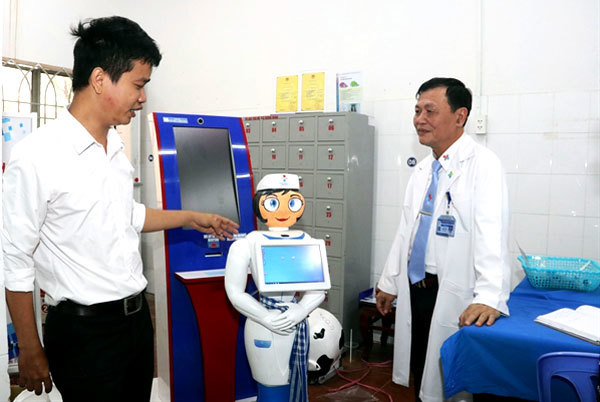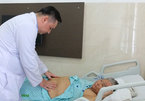 |
|
Vo Hong Quan, director of the Centre of Information and Technology under the Eastern People Military Hospital in HCM City (left), introduces the nurse robot named Tam.
|
And despite plenty of hard work on a daily basis, you will not find her complaining about being tired – although you may have to charge the nurse from time to time.
Tam is the first ‘robot’ nurse to help clinical staff perform routine work.
She has the appearance of a nurse, complete with tradition clothing worn by other medical staff at the hospital.
Tam is designed to be able to move around, have face recognition system, remember certain tasks such as remembering patients' name and giving patients directions.
And the robotic medic can also have conversation with patients about medical issues, nutrition diets, and measures to prevent popular illnesses.
An electronic board is designed to help patients look up the list of hospital fees and allow medical appointments to be made by specialists.
The nurse robot has turned the hospital into a highlight of HCM City's medical industry in applying information technology to build a smart healthcare system for patients.
Colonel Truong Hoang Viet, director of the Eastern People Military Hospital, said the robot was the result of application of intelligent technology, which was built on the basis of the universal connectivity technology.
The robot had the ability to identify faces and also break down language barriers.
But if that’s not enough, Tam also can identify and stop careless actions or behaviours such as smoking in the hospital campus or littering.
The nurse robot is among sixteen initiatives in which the hospital has applied information technology to improve medical examinations and treatment quality.
Patients can access medical support from high-technology equipment. Four smart registration kiosks have been installed to help people quickly carry out registration procedures without requiring the guidance of medical staff.
By simply inserting a medical insurance card or a flashcard supplied by the hospital to the infrared eye for identification, all patient information will be recorded.
After patients choose the content of examination, the screen will immediately display the clinic they need to go for check-up and treatment.
These kiosks can check the validity of a health insurance card, capture patients' image with the front camera, and work closely with the hospital's overall management software to receive patients’ feedback on service quality.
The hospital has also implemented a range of other IT applications such as Room Access Control System, Disabled Robot Arm, and smart medical record cabinets.
Le Thi Men, a 72-year-old patient living in District 9’s Long Binh Ward, said she was surprised by the changes in the hospital over the years.
“I am very interested in the machines that the hospital has been equipped with from the lobby to the toilet. Auto technology products are everywhere to give us instructions,” she said.
Explaining about the information technology development at the hospital, Colonel Viet said the hospital was the first to be given financial autonomy in the country, so it faced various difficulties.
Old and degraded facilities as well as a shortage of medical staff has reduced the quality of medical examination and treatment. Therefore, the number of patients coming to seek medical treatment was very few.
“We were concerned about how to improve the hospital’s quality while maintaining the cost of treatment and the number of staff,” Viet said.
“There was only one way - application of information technology to solve the problem.”
That’s when the Information Technology Centre was founded.
The hospital’s Board of Directors had constantly developed creative ideas to improve the medical examination and treatment process based on the actual operational needs of the hospital.
A series of innovative ideas have been nominated by hospital staff and the centre helped turning them into high technology products.
Colonel Trinh Ngoc Chi, deputy director of the hospital, said thanks to high-technology products, more people came to the hospital, rising from 700-800 patients in recent years to 1,800 patients at the peak per day.
The hospital’s management has also been easier. Chí said the board of directors would know what toilets needed to be cleaned and what areas were overloaded with patients via smart medical monitoring system.
Chi said the hospital would continue promoting the application of information technology in hospital management and operation, especially artificial intelligence to give the best services to patients. — VNS

Vietnam uses robot surgery for first time on kidney cancer patient
Doctors at Binh Dan Hospital in HCM City used a robot to assist surgery in late April to remove a cancerous tumour from a 70-year-old Vietnamese woman from Tien Giang Province in the Mekong Delta.
 Tam’s role as a nurse at the Eastern People Military Hospital in HCM City is crucial to the health and well being of patients.
Tam’s role as a nurse at the Eastern People Military Hospital in HCM City is crucial to the health and well being of patients.